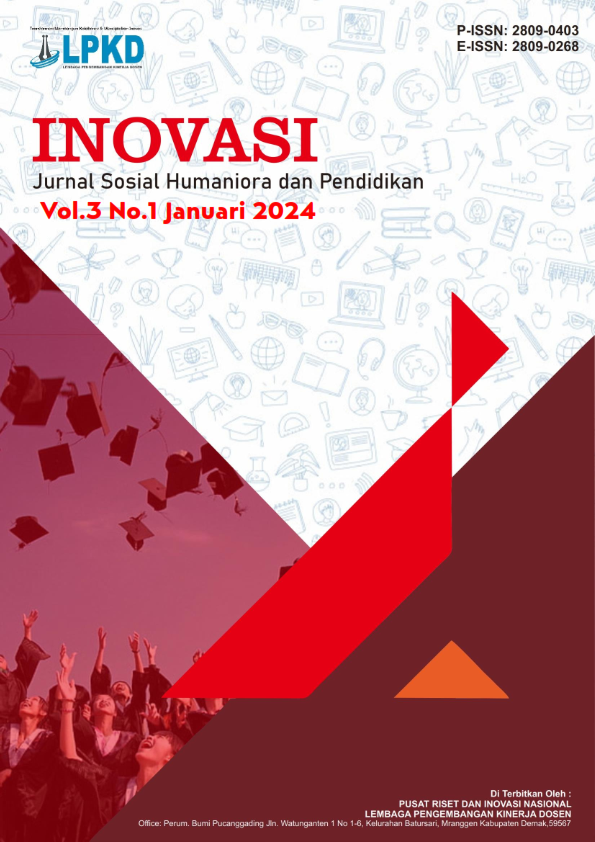Analisis Potensi Antimikroba Ekstrak Kunyit (Curcuma longa) terhadap Bakteri Patogen Usus di Desa Sobawagoli
DOI:
https://doi.org/10.55606/inovasi.v3i1.5774Keywords:
Antimicrobial, Curcuma Longa, Intestinal Pathogenic Bacteria, Traditional Medicine, Turmeric ExtractAbstract
This study aims to analyze the antimicrobial potential of turmeric extract (Curcuma longa) against intestinal pathogenic bacteria in Sobawagoli Village, as well as to determine the utilization and perception of the community regarding the use of turmeric extract as a natural antimicrobial agent. The research method used was a case study with a descriptive qualitative approach through data collection techniques such as observation, interviews, and documentation. The results showed that most of the community in Sobawagoli Village had used turmeric as a traditional medicine to treat digestive disorders such as diarrhea, flatulence, and coughs. Turmeric is used in simple ways, such as boiling, grating, or squeezing to extract the juice. The curcumin and essential oil content in turmeric rhizomes are known to have antibacterial activity that can inhibit the growth of intestinal pathogens such as Escherichia coli and Shigella dysenteriae. The community has a positive perception of the effectiveness of turmeric as a natural medicine that is safe, easily available, and affordable. The results of this study confirm that the use of turmeric as an antimicrobial has a scientific basis as well as important local wisdom value that should be developed in traditional natural medicine.
References
Al-Seghayer, M. S., & Al-Sarraj, F. M. B. (2021). The outbreak of foodborne disease by pathogenic Enterobacteriaceae antimicrobial resistance – A review. Asian Food Science Journal, 91–99. https://doi.org/10.9734/afsj/2021/v20i630312
Apriliantisyah, W., Haidir, I., Rasfayanah, Sodiqah, Y., & Said, M. F. M. (2022). Daya hambat ekstrak kunyit (Curcuma domestica Val) terhadap bakteri Staphylococcus aureus dan Escherichia coli. Fakumi Medical Journal: Jurnal Mahasiswa Kedokteran, 2(10), 694–703. https://doi.org/10.33096/fmj.v2i10.127
Bustami, K., Saifrizal, M., Maulana, M., Chadafi, M. F., & Abdullah, A. (2022). Development of Curcuma caesia (black turmeric) cultivation as a leading local traditional medicine plant. PKM-P, 6(2), 442. https://doi.org/10.32832/jurma.v6i2.1608
Elshafie, H. S., Camele, I., & Mohamed, A. A. (2023). A comprehensive review on the biological, agricultural and pharmaceutical properties of secondary metabolites based-plant origin. International Journal of Molecular Sciences, 24(4), 3266. https://doi.org/10.3390/ijms24043266
Etemadi, S., Barhaghi, M. H. S., Leylabadlo, H. E., Memar, M. Y., Mohammadi, A. B., & Ghotaslou, R. (2021). The synergistic effect of turmeric aqueous extract and chitosan against multidrug-resistant bacteria. New Microbes and New Infections, 41, 100861. https://doi.org/10.1016/j.nmni.2021.100861
Jyotirmayee, B., & Mahalik, G. (2022). A review on selected pharmacological activities of Curcuma longa L. International Journal of Food Properties, 25(1), 1377–1398. https://doi.org/10.1080/10942912.2022.2082464
Mittraparp-Arthorn, P., Ungphaiboon, S., Takahashi Yupanqui, C., Suwannasin, S., Wijukkul, C., Tanmanee, N., & Srichana, T. (2024). The potential of turmeric extract-loaded chitosan microparticles for the treatment of gastrointestinal disorders. Journal of Microencapsulation, 41(7), 547–563. https://doi.org/10.1080/02652048.2024.2390958
Muliana, G. H., Rasyid, M., & Hasanah, U. (2023). Potensi herba & rempah sebagai tanaman obat keluarga. BIOMA: Jurnal Biologi dan Pembelajarannya, 5(2), 1–11. https://doi.org/10.31605/bioma.v5i2.2883
Rahmat, F. (2020). Manfaat senyawa kurkumin dalam kunyit pada pasien diare. Jurnal Medika Hutama, 2, 255–260. Retrieved from http://www.jurnalmedikahutama.com/index.php/JMH/article/view/63
Rohmah, G. M., Hayati, A., & Rahayu, T. (2021). Studi etnobotani kunyit (Curcuma) pada masyarakat Desa Klabetan Kecamatan Sepulu Kabupaten Bangkalan Madura Jawa Timur. BIOSAINTROPIS (Bioscience-Tropic), 7(1), 104–110. https://doi.org/10.33474/e-jbst.v7i1.427
Rohmah, M. N. (2024). Pemanfaatan dan kandungan kunyit (Curcuma domestica) sebagai obat dalam perspektif Islam. Es-Syajar: Journal of Islam, Science and Technology Integration, 2(1), 178–186. https://doi.org/10.18860/es.v2i1.18151
Rukin, S. P. (2019). Metodologi penelitian kualitatif. Yayasan Ahmar Cendekia Indonesia.
Song, Z., Wu, Y., Wang, H., & Han, H. (2019). Synergistic antibacterial effects of curcumin modified silver nanoparticles through ROS-mediated pathways. Materials Science and Engineering: C, 99, 255–263. https://doi.org/10.1016/j.msec.2018.12.053
Talukder, S. H., Islam, T., Asad, H. B., Salahin, K. F., Sultana, U. F., & Akter, S. (2022). Indigenous knowledge and practice related to health, nutrition, and environments in Bangladesh. In Socio-Ecological Systems and Decoloniality (pp. 209–231). Springer International Publishing. https://doi.org/10.1007/978-3-031-15097-5_10
Thavorn, K., Wolfe, D., Faust, L., Shorr, R., Akkawi, M., Isaranuwatchai, W., Klinger, C., Chai-Adisaksopa, C., Tanvejsilp, P., Nochaiwong, S., Straus, S. E., & Hutton, B. (2024). A systematic review of the efficacy and safety of turmeric in the treatment of digestive disorders. Phytotherapy Research, 38(6), 2687–2706. https://doi.org/10.1002/ptr.8189
Uthman, A. I., Obafunmi, T. I., Shitu, S., & Bello, N. U. (2024). Evaluation of antibacterial activity of Curcuma longa (turmeric) extract against Escherichia coli and Staphylococcus aureus. https://doi.org/10.21203/rs.3.rs-4350775/v1
Vaou, N., Stavropoulou, E., Voidarou, C., Tsigalou, C., & Bezirtzoglou, E. (2021). Towards advances in medicinal plant antimicrobial activity: A review study on challenges and future perspectives. Microorganisms, 9(10), 2041. https://doi.org/10.3390/microorganisms9102041
Vo, T. S., Vo, T. T. B. C., Vo, T. T. T. N., & Lai, T. N. H. (2021). Turmeric (Curcuma longa L.): Chemical components and their effective clinical applications. Journal of the Turkish Chemical Society Section A: Chemistry, 8(3), 883–898. https://doi.org/10.18596/jotcsa.913136
Zebua, N., & Zebua, E. N. K. (2023). Ragam jenis dan pemanfaatan tanaman obat keluarga pada masyarakat Desa Fadoro Sitoluhili. Jurnal Teknik, Komputer, Agroteknologi dan Sains, 2(1), 69–78. https://doi.org/10.56248/marostek.v2i1.86
Zheng, D., Huang, C., Huang, H., Zhao, Y., Khan, M. R. U., Zhao, H., & Huang, L. (2020). Antibacterial mechanism of curcumin: A review. Chemistry & Biodiversity, 17(8). https://doi.org/10.1002/cbdv.202000171
Downloads
Published
How to Cite
Issue
Section
License
Copyright (c) 2023 Jurnal Sosial Humaniora dan Pendidikan

This work is licensed under a Creative Commons Attribution-ShareAlike 4.0 International License.







